
グロッシュラーガーネットの宝石:特性、意味、価値など
 グロッシュラーガーネットは、ツァボライトやヘソナイトといった人気の変種を含むガーネットファミリーに属する宝石です。このグループは最も色の多様性に富み、青を除くあらゆる色を揃えており、天然で宝石品質の無色のガーネットは唯一です。しかしながら、このグループの石はジュエリーにはあまり使用されていません。
グロッシュラーガーネットは、ツァボライトやヘソナイトといった人気の変種を含むガーネットファミリーに属する宝石です。このグループは最も色の多様性に富み、青を除くあらゆる色を揃えており、天然で宝石品質の無色のガーネットは唯一です。しかしながら、このグループの石はジュエリーにはあまり使用されていません。
グロッシュラーガーネットは珍しいのでしょうか?ツァボライトや無色の「ロイコ」ガーネットなど、一部の品種は希少ですが、全体的には広く分布しています。
他のガーネットとは異なり、グロッシュラーガーネットの色は赤ではなく、一般的に緑色です。さらに、バーモント州はグロッシュラーガーネットを州の宝石として崇めています。
もっと詳しく知りたいですか?グロッシュラーガーネットの種類、特性、意味、価格などについて詳しく知るには、読み進めてください。
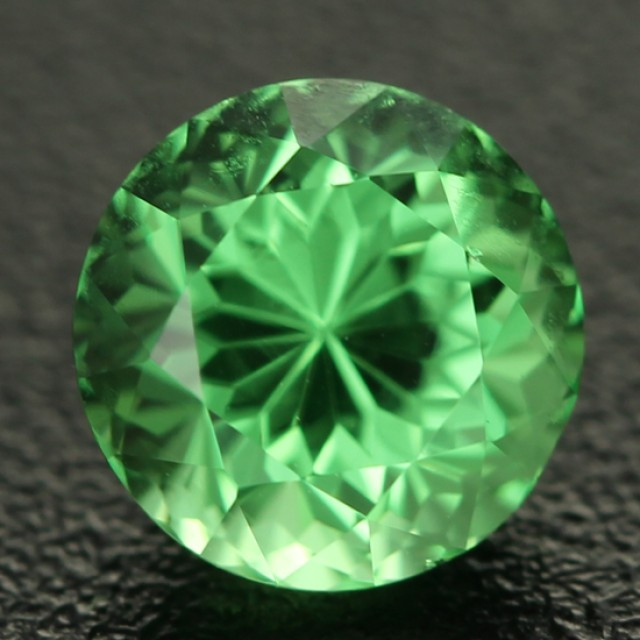
グロッシュラーガーネットとは何ですか?
グロッシュラーガーネット、またはグロッシュラーライトガーネットは、様々な色の変種が存在する半貴石です。「グロッシュラーライト」という用語は厳密には同義語ですが、国際鉱物学協会(IMA)は「グロッシュラーライト」と呼ばれる岩石との混同を避けるため、この用語の使用を推奨していません。
グロッシュラーガーネットの他の呼び名には以下のものがあります。
コロホナイト(粗粒)
エルナイト
グーズベリーガーネット
オリンソリテロリソリテ
ロマンゾビテ
テルマルカイト
販売者によっては、アフリカ翡翠、ガーネット翡翠、トランスバール翡翠、南アフリカ翡翠などの誤った名称を使用する場合があります (ただし、使用すべきではありません)。
ガーネットと同様に、グロッシュラー宝石は1 月の誕生石、 結婚 2 周年記念の宝石、 山羊座または 水瓶座の幸運の石です。

グロッシュラーガーネットの仕様と特徴
複合ガーネットファミリーにおいて、グロッシュラーガーネットはウバロバイトやアンドラダイトとともに、カルシウムを主成分とするウグランダイト系列に属します。グロッシュラーガーネットはカルシウムアルミニウムケイ酸塩ですが、カルシウムとアルミニウムの一部が鉄に置換されていることがあります。
その他のガーネットの変種には、ロードライトやマラヤガーネットのように、痕跡量のグロッシュラーが含まれることがあります。
ガーネットがグロッシュラーガーネットかどうかはどうやってわかりますか?
まず、グロッシュラーガーネットは、暗い色や赤色になることはほとんどありません。次に、内部に(透輝石結晶由来の)明確な渦巻き模様、不規則な条線、そして異常な複屈折が見られ、これらはすべて顕微鏡で観察できます。最後に、結晶は通常、帯状に並び、双晶構造を呈し、しばしば条線が見られます。
グロッシュラーガーネットの特性は次のとおりです。
モース硬度:6.5~7.5
色: 白、灰色、無色、黄色、黄緑、緑系、茶色、ピンク、オレンジ、オレンジレッド、赤、黒
結晶構造:等軸晶(立方晶)
光沢:ガラス質、油状、樹脂状、または金剛光沢
透明性:半透明から透明
屈折率:1.72~1.80
密度:3.40~3.73
胸の谷間:なし
骨折:不規則または貝殻状
縞模様:白から淡い茶色がかった白または茶色
発光: 蛍光およびX線色が存在する場合がある。無色から薄緑色の石: LW-UVではオレンジ色、SW-UVでは黄橙色。黄色の石: LW-UVおよびSW-UVではオレンジ、ピンク、または赤色。塊状の物質、一部のファセットカットされた宝石、および黄色のタンザニア産標本: X線ではオレンジ色。
多色性:なし
複屈折:なし;時々異常あり
分散:0.027~0.028(中程度)
 上の写真:インペリアルガーネット
上の写真:インペリアルガーネット
グロッシュラーガーネットの種類
グロッシュラーガーネットにはいくつかの変種があり、他のガーネット種との混合もあります。グロッシュラーガーネットのサブタイプの中には、単に色で命名(または区別)されているものもあります。
グーズベリーガーネット:薄緑から薄緑がかった茶色
グリーン・グロッシュラー・ガーネット:青緑から黄緑
インペリアルガーネット:淡いピンクからザクロ色、オレンジから黄色の色合いのものが多い
ミントガーネット:淡いミントグリーン。タンザニアのメレラニ産のためメレラニミントガーネットとも呼ばれる。桃色のLW-UV蛍光にちなんで「UVガーネット」という愛称も付けられている。
ラズベリーガーネット:ラズベリーレッド
商標名が付けられている品種には次のようなものがあります。
カリフォルナイト:淡緑色から中緑色のグロッシュラー石とイドクレース(ベスブ石)の混合物
ロソライト:淡いピンクからラズベリーレッド。「ランデライト」または「ザロストサイト」とも呼ばれる。
ビリュイテ:オリーブグリーン、時には赤や茶色
重要なグロシュラー変種には以下のものがあります:
ヘソナイト

ヘソナイトは、黄色がかった赤色から赤みがかったオレンジ色のグロッシュラー石の一種で、「シナモンストーン」とも呼ばれます。この宝石は、琥珀色の滑らかな色合いで、「ウイスキーを水に浸したような」外観を呈することが多いです。
その名前はギリシャ語の「劣った」を意味するhēssōnに由来しており、ほとんどのガーネットよりもモース硬度と密度が低いことに由来しています。
ツァボライト

グロッシュラーガーネットとツァボライトの違いについて疑問に思われる方もいらっしゃるかもしれません。どちらも同じものです!ツァボライトは、美しい緑色のグロッシュラーガーネットの中でも希少で、大変人気のある品種です。エメラルドよりも耐久性が高く、 内包物が少ないため、エメラルドの代替品として最適です。
ツァボライトは、アンドラダイト属の別の緑色のガーネットであるデマントイドと混同されることがあります。
マリガーネット
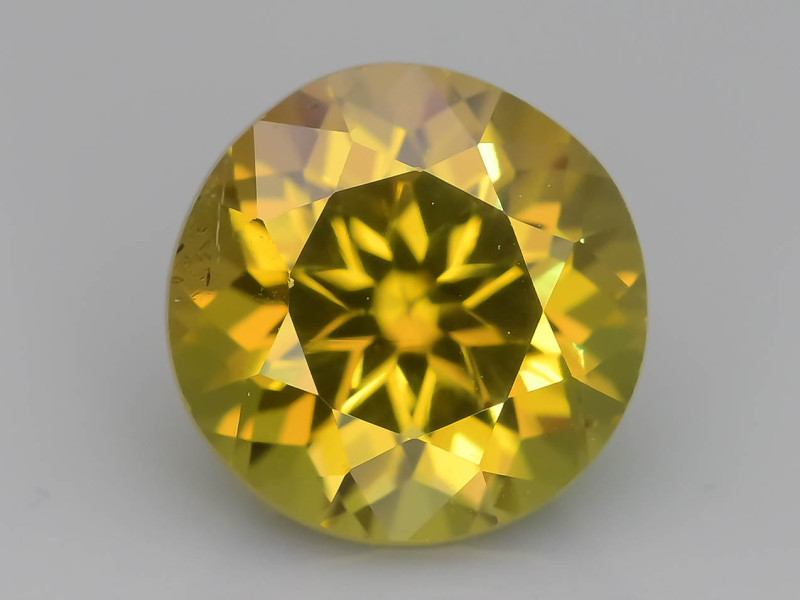
マリガーネットは、アンドラダイトとグロッシュラーが混ざり合った、非常に希少な黄色、緑、または茶色のガーネットです。「グランダイトガーネット」とも呼ばれ、鮮やかで均一な色合いと素晴らしい輝きを放ち、アフリカのマリ産のみで産出されます。
ロイコガーネット
ロイコガーネット(またはロイコガーネット)は、透明で無色の極めて珍しいグロッシュラー変種です。
ハイドログロシュラーガーネット(議論中)

ハイドログロッシュラー・ガーネットがグロッシュラー変種(あるいは真のガーネット変種)であるかどうかは議論の余地がありますが、多くの宝石学者はそうであると主張しています。ハイドログロッシュラー・ガーネットはグロッシュラーと同じ組成を持ちますが、シリカの一部が水酸化物に置換されています。
ハイドログロッシュラーガーネットは、一般的に緑、青緑、白、ピンク、または灰色で、多くの場合、黒っぽい胡椒のような磁鉄鉱の斑点が付いています。

グロッシュラーガーネットの意味と歴史
形而上学的に、グロッシュラーガーネットは豊かさ、力、そして成功を象徴しています。自然の育みと再生を反映し、友情と愛情を象徴しています。
歴史
公式に認められた最初のグロッシュラーガーネットは、ロシアのアフタラグダ川産でした。ドイツの鉱物学者アブラハム・ゴットロープ・ヴェルナーは、1803年にこれをカネルシュタイン(ドイツ語で「シナモン石」)と命名し、1808年に「グロッシュラーライト」と改名しました。
グロシュラリテという名前は、元の標本の色が淡い緑色のグーズベリー、または Ribes grossularia に似ていることに由来しています。
ヘソナイトの歴史は遥か昔に遡ります。古代ギリシャ・ローマ時代には宝飾品や彫刻に愛用されていました。実際、ジルコンと思われていた歴史的な彫刻が施された宝石の多くは、実はヘソナイトでした。
ツァボライトとマリガーネットの発見は、グロシュラーガーネットの現代における認知度を高めました。まず、スコットランド系ケニア人の宝石学者キャンベル・ブリッジズが1967年にタンザニアでツァボライトを発見し、その後まもなくケニアでも発見されました。ケニアのツァボ国立公園での発見がツァボライトの名称の由来となりました。
2 つ目の注目すべき変種であるマリガーネットは、1994 年にマリで発見されました。
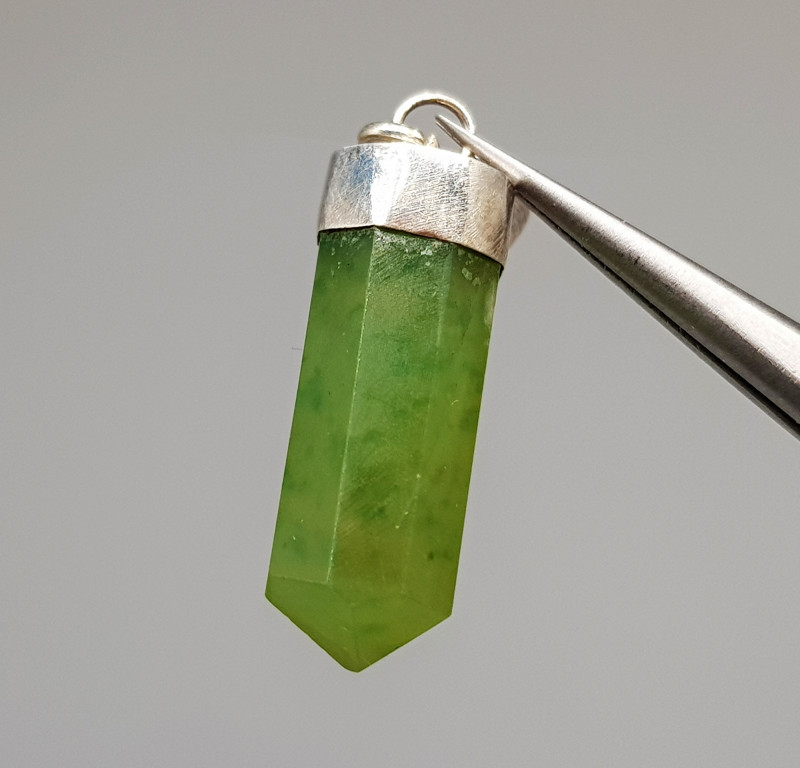
グロッシュラーガーネットの治癒特性
グロッシュラーガーネットはヒーリングストーンとして強力な効果を発揮します。他の 緑色の宝石と同様に、グリーングロッシュラークリスタルは若返りと滋養を与えます。また、ハートチャクラにも効果があります。一方、ヘソナイトのようなオレンジ色の宝石は、集中力と創造性を高めます。
グロッシュラーガーネットは身体にどのような良い効果がありますか?
身体の治癒
クリスタルヒーラーは、以下の症状の補助や治療にグロッシュラーガーネットを推奨しています。
炎症
細胞再生
呼吸器疾患
代謝調節
感情的な癒し
グロッシュラーガーネットは、感情のバランスを整え、感謝の気持ちを促し、他人が自分についてどう思っているかを気にせずに他人を助けることに集中できるように促すのにおすすめです。

グロッシュラーガーネットの宝石特性
グロッシュラーガーネットの価値は、色、カット、透明度、カラット重量、処理方法によって等級分けされます。
色
グロッシュラーガーネットの色は、ほとんどが淡色から中程度の色調で、緑色をしていることが多いです。純粋なものは無色ですが、希少です。不純物によって、ツァボライトやミントガーネットグリーンの背後にあるバナジウムやクロムのように、新たな色合いが生まれます。
カット
多くのグロッシュラーガーネットはファセットカットされていますが、特定の品種では稀です。ハイドログロッシュラーガーネットは通常カボションカットされ、塊状の白い素材は彫刻されることもあります。
明瞭さ
ガーネットはタイプII の有色宝石クラリティを持つため、目に見える程度の小さな内包物が存在することが予想されます。一般的なグロッシュラー内包物には以下のものがあります。
さまざまな品種には特定の含有物があります:
ヘソナイト:丸みを帯びたずんぐりとした結晶、油っぽい「スコッチ・イン・ウォーター」または「ヒートウェーブ」効果
ツァボライト:黒鉛板、治癒した骨折、羽毛、指紋、針、繊維状アスベスト
ミントガーネット:グラファイト小板、治癒した骨折、シルク、丸い鉱物
ハイドログロシュラー:マグネタイト
緑色グロッシュラー:針状または棒状の結晶
ロイコ:治癒した骨折、ミネラル
マリガーネットは肉眼で見てきれいなものが多いですが、中には指紋状のものや平行な成長面に沿って小さな結晶が見られるものもあります。
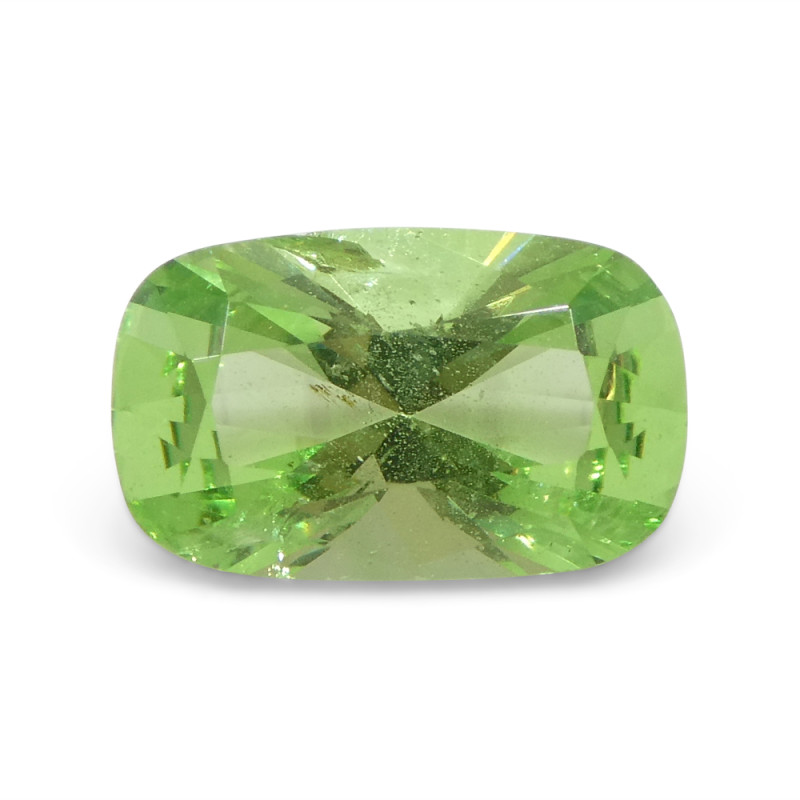
カラット重量とサイズ
グロッシュラーガーネットは、特にカボションや彫刻用に、特大サイズのものが数多くあります。ヘソナイトは数百カラットのものもありますが、小型の標本の方が透明度が高くなります。同様に、ツァボライトは通常1カラット未満でのみ良好な透明度を示します。ミントガーネットは通常1カラット未満です。
これらの品種のうち、サイズが大きく、透明度の高いものは非常に価値があります。
トリートメントと合成
グロッシュラーガーネットは、ルビーを模倣するために染料処理されることは稀です。宝石学者は、淡色または無色のグロッシュラーガーネットを黄緑色に変える放射線照射実験を行ってきましたが、これは不安定です。
科学者たちは研究目的ではあるものの、商業目的ではないため、 合成グロッシュラーガーネットを作成した。

グロッシュラーガーネットの形成と産地
ガーネットは通常、堆積岩が地下深くの熱と圧力によって変成作用を受け、内部の鉱物がガーネットに変化することによって形成されます。
グロッシュラーガーネットは、接触変成作用を受けた石灰岩や不純な石灰質岩、片岩、蛇紋岩中に産出します。
採掘場所
グロッシュラーガーネットはどこから産出されるのでしょうか?世界中から!主な産地は以下のとおりです。
オーストラリア
ブラジル
カナダ
中国
イタリア
ケニア
マダガスカル
マリ
メキシコ
ミャンマー
パキスタン
ロシア
南アフリカ
スリランカ
スイス
タンザニア
アメリカ合衆国(カリフォルニア州、ニューイングランド州、バーモント州、ワシントン州)
ヘソナイトは主にスリランカとインドから産出されますが、ブラジルやカリフォルニアからも産出されます。ロイコガーネットは主にミャンマーとスリランカから産出されます。ツァボライトはタンザニアとケニアからのみ産出されます。ミントガーネットはタンザニア、ケニア、マダガスカルから産出されます。
さて、グロッシュラーガーネットの価値はいくらでしょうか?
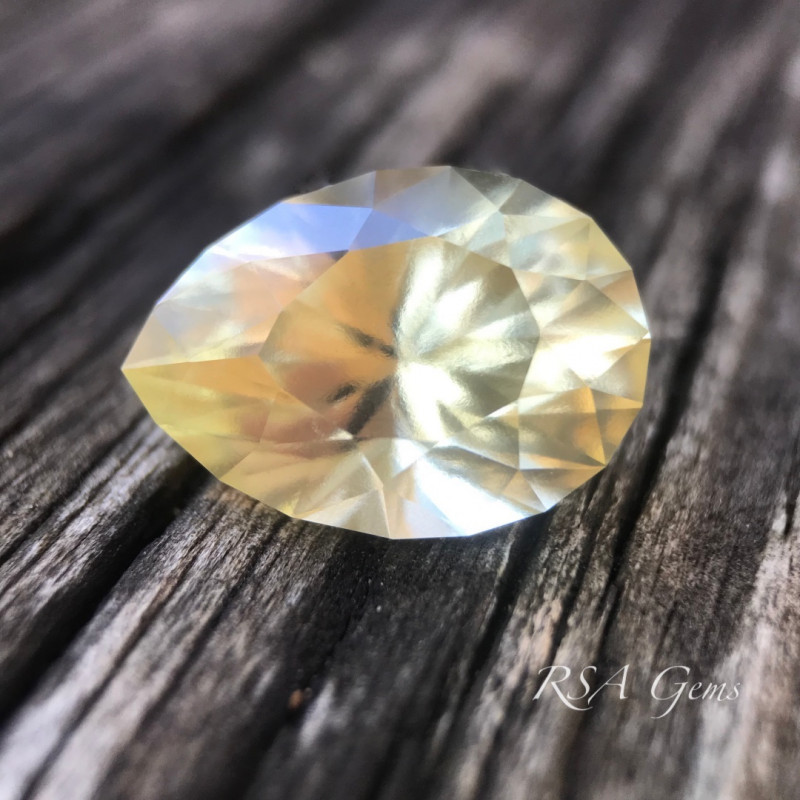
グロッシュラーガーネットの価格と価値
グロッシュラーガーネットの1カラットあたりの価格は、品質、種類、サイズによって異なります。
基本的な色とサイズ別にファセットグロシュラーの価格を見てみましょう。
ミント:0.5~1カラットの場合は1カラットあたり80~200ドル、1~5カラットの場合は1カラットあたり180~850ドル、5カラット以上の場合は1カラットあたり最大900ドル
イエロー/オレンジ: 0.5~1カラットの場合は1カラットあたり10~50ドル、1~5カラットの場合は1カラットあたり最大100ドル、5カラット以上の場合は1カラットあたり最大200ドル
イエロー/グリーン: 0.5~1カラットの場合は1カラットあたり30~600ドル、1カラット以上の場合は1カラットあたり最大600ドル
その他:0.5~1カラットの場合は1カラットあたり70ドル、1~5カラットの場合は1カラットあたり70~300ドル
ファセットカットされたヘソナイトガーネットの価格は、一般的に、サイズを問わず 1 カラットあたり 20 ~ 150 ドルです。
ファセットカットされたツァボライトは、0.5~1カラットの場合は1カラットあたり300~800ドル、1~2カラットの場合は1カラットあたり500~3,500ドル、2カラット以上の場合は1カラットあたり600~10,000ドルです。
マリ産ガーネットは、ファセットカットされており、サイズを問わず 1 カラットあたり 75 ドルから 1,500 ドルの価値があります。
どの色のカボションも、通常は 1 カラットあたり 1 ~ 20 ドルです。
グロッシュラーガーネットのお手入れとメンテナンス
最後に、 宝石のケアについてです。硬度の範囲が広いため、グロッシュラーガーネットのリングには保護セッティングをお勧めします。
内包物の多いグロッシュラーガーネットは、より脆くなります。グロッシュラーガーネットは熱に弱いため、高温や機械洗浄システムへの曝露は避けてください。
グロッシュラーガーネットは、中性洗剤、ぬるま湯、柔らかい歯ブラシで洗います。

グロッシュラーガーネットに夢中になっていませんか?
グロッシュラーガーネットは、ガーネットファミリーの中でも過小評価されている宝石です。ほぼあらゆる色、あらゆる予算に対応する価格、そして美しい輝き。愛さずにはいられないでしょう。
Gemstone Encyclopedia検索
最新記事
ヤシ象牙彫刻は、植物象牙とも呼ばれ、南米のヤシ科植物フィテレファス属のヤシの実から倫理的に採取された、象牙の天然代替品です。このガイドでヤシ象牙についてすべて学びましょう!
15th Jan 2026
レインボーラティスサンストーンは、様々な内包物によって3つのゴージャスな光学的効果を持つ長石の一種です。燃えるように鮮やかな色合いと格子模様が、コレクターにとって希少な宝石となっています。
12th Jan 2026
記事のカテゴリ
How To's is where you will find helpful articles from gem Rock Auctions on how to cut gemstones, select gemstones and buy gemstones.
9記事数
